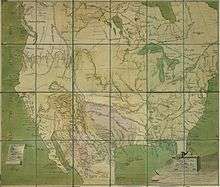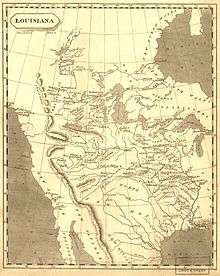Nemesio de Salcedo
Part of a series on the |
||||||||||||||||||
|---|---|---|---|---|---|---|---|---|---|---|---|---|---|---|---|---|---|---|
| History of Texas | ||||||||||||||||||
 | ||||||||||||||||||
| Timeline | ||||||||||||||||||
|
||||||||||||||||||
|
| ||||||||||||||||||
Nemesio de Salcedo (fl. 1804 - 1813) was a Spanish colonial official who served as the Commandant-General of the Provincias Internas, which at the time included much of modern Mexico and the Southwestern United States.
Early life and family
Salcedo was a native of Bilbao in Spain. He was the brother of Juan Manuel de Salcedo, the last governor of Spanish Louisiana,[1] and the uncle of Manuel María de Salcedo, governor of Spanish Texas.
Commandant of the Provincias Internas

Salcedo was appointed to the position of Commandant-General of the Provincias Internas in 1804, succeeding Pedro Grimarest. This position included military responsibilities as well as direction of finance and postal functions in the territory. With little oversight due to the remoteness of the region, he was able to use his position to amass a significant private fortune.[2] His administration occupied a tumultuous period of the region's history, including the Louisiana Purchase, which brought the borders of the United States to the edge of Texas, and the War of Mexican Independence.
Border disputes

The language in the Third Treaty of San Ildefonso, which had ceded Spanish Louisiana back to France, was vague on the exact location of the border between French and Spanish territory, and this vagueness led to tensions between Spain and the United States. Thomas Jefferson asserted that the newly-purchased American territory extended well into Spanish-claimed lands, to the Rio Grande and Rocky Mountains, and American expeditions set out to survey and explore the border areas. Salcedo was alarmed at American incursions into Spanish territory; he went so far as to send a party to the Pawnees bearing lavish gifts, with the request that they capture American interlopers and bring them to Santa Fe.[3] One group of explorers, in 1806, was turned back while navigating the Red River by Spanish troops. Salcedo had ordered troops sent to the Texas-Louisiana border in advance of a possible confrontation, and by the time of the 1806 incident there were more than 1300 Spanish troops stationed in Texas, with most of those at Nacogdoches. Fortunately for both sides, both sides proceeded with caution. Salcedo ordered his subordinates not to initiate hostilities, while the king of Spain sent orders to make every effort to solve disputes peacefully. A neutral ground agreement was negotiated that prevented open hostilities between the two sides.[4] In the meantime, Salcedo closed the Texas border to immigration from Louisiana; even Spanish immigrants were barred from entering via this route, being required instead to enter via Veracruz, and only with the permission of the viceroy.[5]
War of Independence
The next major event in Salcedo's administration was the Mexican War of Independence. When war broke out in the south of Mexico, Salcedo made every effort to prevent it from spreading into his territory in the north. While his military achievements were not notable, he did superintend the trial and execution of the insurgent leader Miguel Hidalgo in 1811.[2] Despite his efforts, the revolution spread into the Provincias Internas; among the casualties of the fighting was his nephew Manuel, who was one of the royalist leaders executed after the Battle of Rosillo Creek in 1813.
Return to Spain
Though some sources report Nemesio Salcedo among the casualties at the Battle of Rosillo Creek (in addition to his nephew), this is in error. He was recalled to Spain in 1813, after which the Provincias Internas were divided into eastern and western parts. He was succeeded in the east by José Joaquín de Arredondo.[6]
References
- ↑ Robertson, James Alexander, "Louisiana Under the Rule of Spain, France, and the United States, Vol. II" pg. 145
- 1 2 Bancroft, Hubert Howe, "History of the North Mexican States and Texas" pp. 582-4
- ↑ Harris, Matthew L., Buckley, Jay H., "Zebulon Pike, Thomas Jefferson, and the Opening of the American West" pg. 139
- ↑ Chipman, Donald E., Joseph, Harriett Denise "Spanish Texas, 1519 - 1821:Revised Edition" pg. 238-9
- ↑ "University of California Publications in History, Volume 8" pg. 701
- ↑ Texas State Historical Association: Provincias Internas